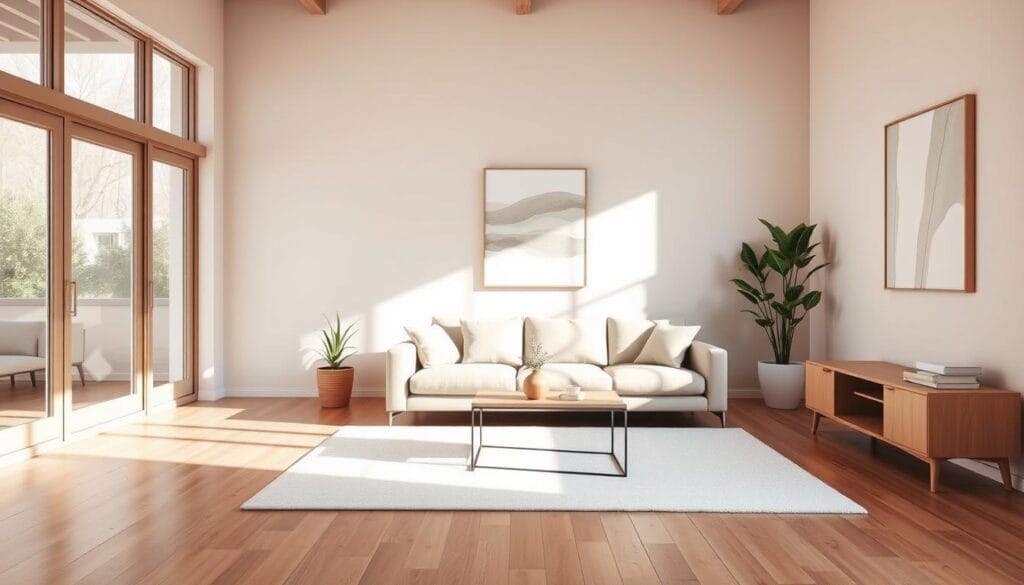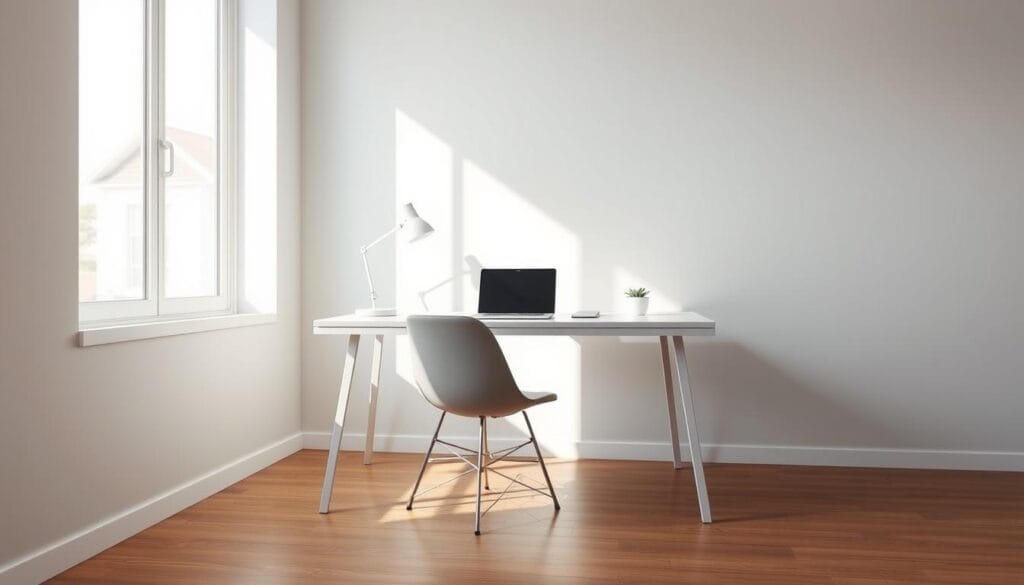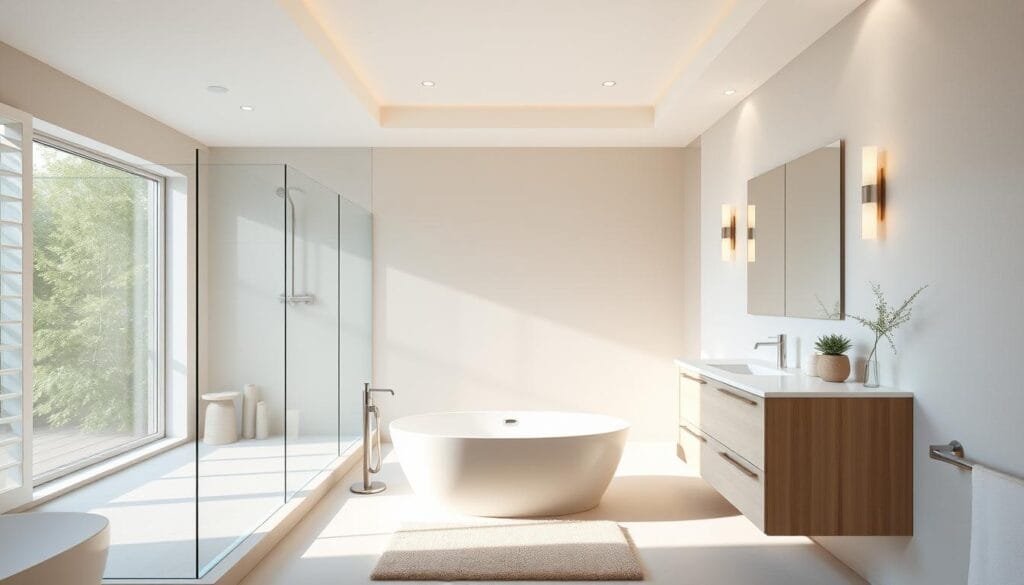When I first found minimalist home decor, my life was full of chaos and clutter. My apartment was packed with too many items, adding to my stress. A friend then showed me minimalist interior design, and things started changing for me.
I began to embrace minimalist architecture bit by bit. I cleaned out one room after another, got rid of stuff I didn’t need, and welcomed simplicity. Soon, my home became a calm haven, proving that “less is more.” Adding neutral colors and more light made my place peaceful and efficient.
Now, let’s dive into the exciting world of minimalist house design. This guide is for anyone interested, whether you’re just curious or improving your minimalist home. We’ll discuss its history, core principles, modern takes, and helpful tips. We’ll see how minimalist design can make our homes beautiful, practical, and supportive.
Picture a home where everything belongs and has a reason. Ready to make your home a peaceful spot? Let’s start this minimalist journey together.
What Is Minimalist House Design?
Understanding minimalist house design is key to making a peaceful home. It’s all about the “less is more” idea, focusing on simple, functional spaces. It combines Scandinavian and Japanese influences, making every element purposeful and avoiding clutter.
Origins of Minimalist Design
Minimalist house design started in the 20th century, drawing from the Dutch De Stijl movement and Japanese traditions. The famous “less is more” phrase was coined by Mies Van Der Rohe, a big name in minimalist architecture. In the 1960s, minimalist art and design became popular, led by designers like Dieter Rams.
- Key Influences: Dutch De Stijl, Japanese aesthetics
- Notable Figures: Mies Van Der Rohe, Dieter Rams
- Materials Used: Concrete, steel, glass, wood
Principles of Minimalist Design
Minimalist homes focus on simple shapes, space, and materials. They often have open plans and smart storage to reduce clutter. Using materials like wood and steel helps achieve a clean look. The color schemes tend to be neutral, using whites, creams, and grays, for a calming feel.
- Open-plan layouts for enhanced functionality
- Integrated storage solutions
- Neutral, calming color schemes
Modern Adaptations
Nowadays, minimalist homes include eco-friendly and smart tech features for sustainability. They focus on natural light and simplicity for efficient, beautiful spaces. Landmarks like the Mies Van Der Rohe Pavilion and the Guggenheim Museum show minimalist design’s lasting influence.
| Key Features | Benefits |
|---|---|
| Eco-friendly elements | Reduces environmental impact |
| Smart home technology | Enhances convenience and efficiency |
| Focus on natural light | Creates a sense of openness and space |
Understanding these principles helps you eliminate clutter and appreciate what’s truly valuable in a minimalist house. It’s about blending style with practicality.
Benefits of Minimalist House Design
Choosing minimalist house plans offers many benefits. One key advantage is less clutter, which means less stress and better mental health.
Less Clutter
Minimalist design means clean lines and lots of open space. It avoids too many items, making your home look neat. Each item in your home will have a clear purpose. Studies show that 60% of people feel calmer in such environments, giving a feeling of peace and order.
Stress Reduction
Minimalist furniture focuses on what’s truly needed, creating peace. You’ll find less clutter and thus, fewer distractions. This improves your focus and mental clarity. Imagine entering a home where you instantly feel at ease. Minimalist homes are seen as 40% more calming than others. Learn more here.
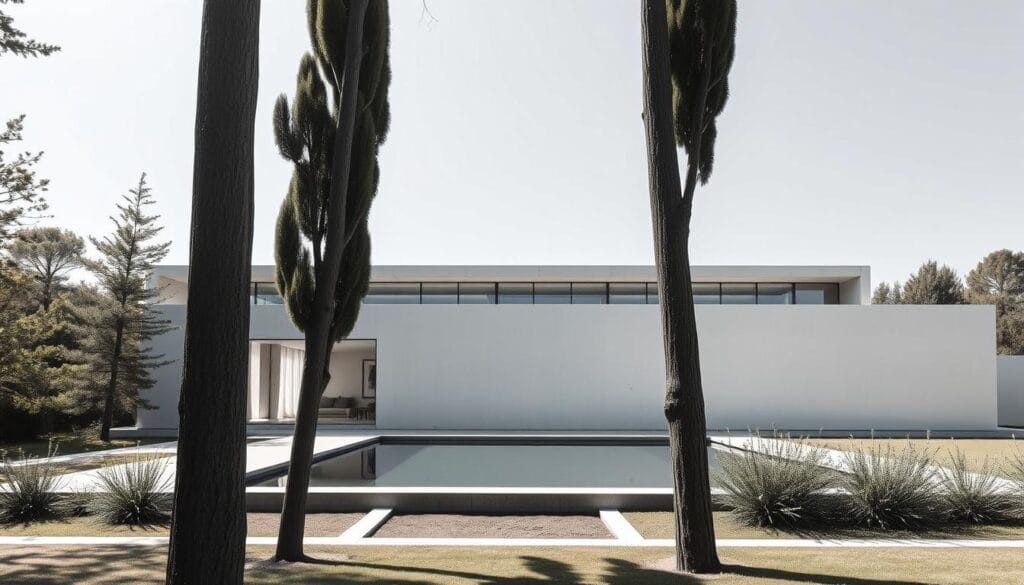
Enhanced Cleanliness
Minimalist homes are easier to clean and maintain. With less to dust and clean, you can save about 40% of your cleaning time. Also, fewer items mean less dust and allergens, making your home healthier and more inviting.
Adopting a minimalist design goes beyond looks. It’s about creating a calm, productive, and healthy living space. With careful planning, you can make your home a peaceful retreat.
Decluttering Your Space
Starting with minimalist design means decluttering first. Doing it room by room is less overwhelming. This way, you see quick changes that motivate you to keep going.
One Room at a Time
Pick a room that stresses you out or is very important, like your living room or kitchen. Start with small areas. Take out things that don’t fit your minimalist style. Using a 5-step method to decide what to keep, throw away, sell, or donate makes this easier.
Identifying Essentials
Minimalist decor means having less but better. Think about if you really need and love each item. If it doesn’t make you super happy, maybe it’s time for it to go. Choose high-quality items over having lots of lower-quality ones. A minimalist living room, for example, needs just a few basics like a sofa, a chair, and a coffee table.
Storage Solutions
Good storage is vital for a minimalist look. Use smart storage like under-bed containers and shelves to keep things out of sight. A vase of flowers or a small plant can brighten the room without clutter. Make sure to keep floors and walls clear for a spacious feel.
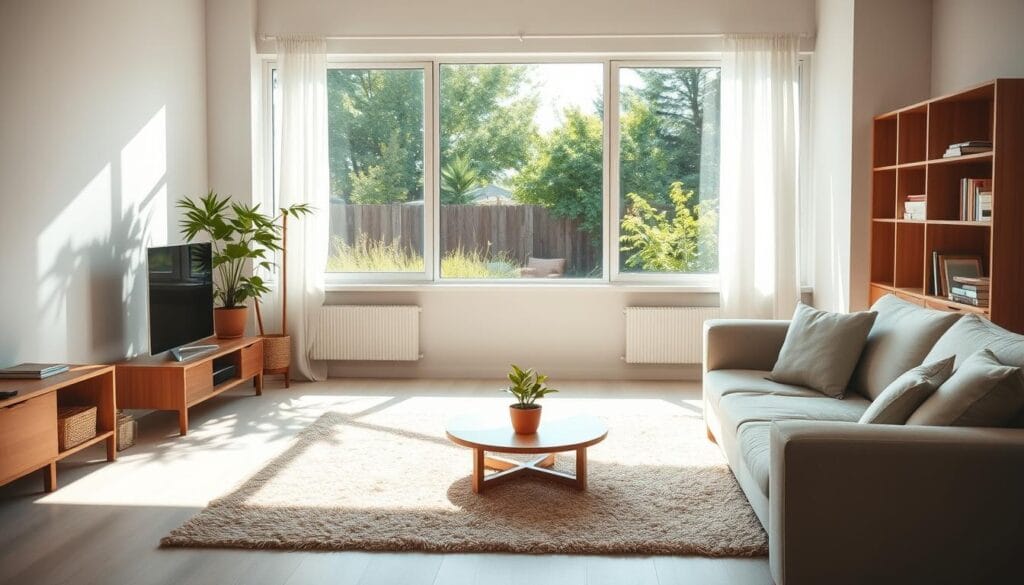
Decluttering makes your space and mind clearer. It makes your place more ordered and easier to handle. Start decluttering today and see your minimalist home improve step by step.
Choosing the Right Furniture
When picking furniture for your minimalist home, balance function and style. Whether you love open spaces or cozy spots, each piece should blend with your minimalist design.
Merging Function and Style
The saying “less is more” guides us in minimalist design. Choose multifunctional furniture like sectionals for more seating without taking up too much space, or a simple white rug to define areas in an open space. Choose durable, sleek tables made of concrete and marble.
Minimalist Furniture Design
Minimalist furniture focuses on simplicity and use. It’s inspired by the De Stijl art, loving geometric shapes more than complex details. Consider durable solid hardwood dining tables or the elegant Sloane King Bed. Remember, it’s better to have one high-quality chair than many small ones.
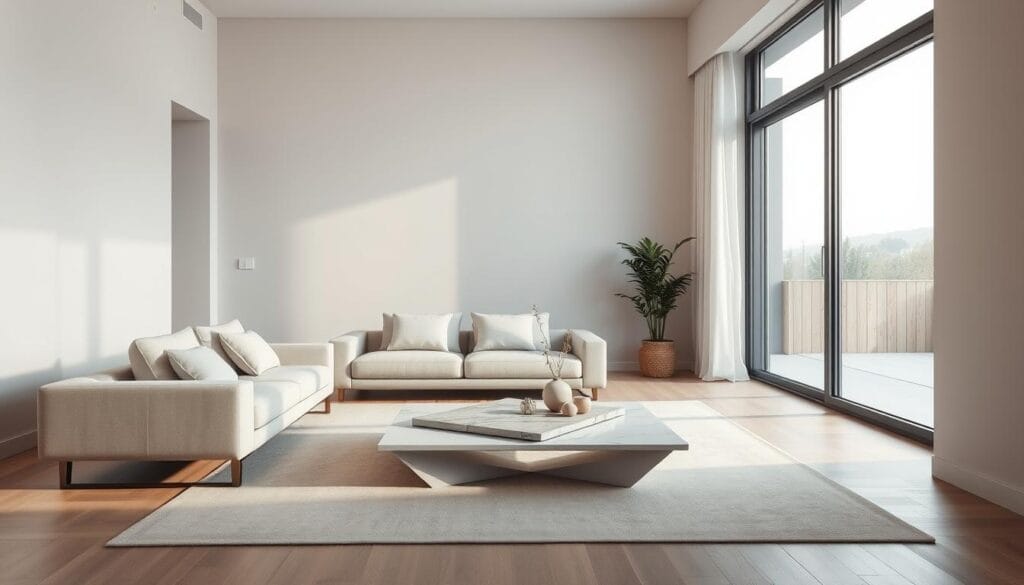
Examples and Inspirations
Look at designs that mix beauty with usefulness. Nesting coffee tables save space and are great for minimalist homes. Pendant lights add mood and function, making any room interesting. Choose bed frames with simple lines and clean bedding like the Cozy Cotton White Quilt for a calm, stylish bedroom.
Be thoughtful with accessories. Mirrors can make a room feel bigger and brighter. Minimalist art uses simple colors to avoid clutter. This way, your home stays stylish and clutter-free, offering peace of mind.
The Role of Color in Minimalist Interiors
Color is vital in a modern minimalist house’s look and feel. It affects the mood and how we see space in minimalist designs. The right colors make a space feel calm and free of clutter.
Neutral Color Schemes
Whites, beiges, and soft grays are key in minimalist decor. About 60% of homeowners choose these colors. They make rooms look bigger and brighter. Neutral tones also cut down on visual clutter by 30-50%. This helps create a clean atmosphere. They can also make you 25% less stressed, boosting peace and well-being.
Accent Colors
Adding accent colors brings depth and vibrancy to minimalist rooms. Joa Studholme says one accent color keeps decor simple yet lively. Pernille Lind suggests bold colors for small spots like bathrooms. Main spaces look great in soft neutrals and pastels. Cushions offer a way to try different colors and fabrics. Adding plants is an easy way to bring in color.
Symmetry and Balance
For harmony in minimalist spaces, it’s all about even color spreading. Edward Bulmer talks about the importance of matching colors with natural materials. A mix of 70% neutral and 30% accent colors is typical. This mix can make spaces feel 10-20% larger. A big part of minimalist design is letting in plenty of natural light. It makes rooms feel 15-30% more spacious and brighter.
House Minimalist Design for Small Spaces
Using minimalist design can make small spaces seem bigger. The idea that “less is more” fits well for those wanting to use space wisely. Through minimalist house plans, even small areas can become both useful and beautiful.

Multi-functional Furniture
Multifunctional furniture is key in minimalist home design. Take a small 27sqm (291sqft) apartment in Sydney as an example. Each piece has more than one use. Sofa beds and nesting tables are perfect for saving space.
These items do more than just fit into small spots. They also make your home look good and work better.
Optimizing Storage
Finding smart storage solutions is vital in a minimalist home. Use the height of your room with tall shelves or hidden spots under stairs. Making the most of overlooked spaces keeps your home tidy and stylish.
Visual Tricks for Expanding Space
Using visual tricks can make rooms feel bigger. Light colors on walls help brighten a room and make it feel larger. Mirrors placed in the right spots add to this effect. They make the room look deeper.
A minimalist loft in Amsterdam shows how smart design adds space. It has a “floating” staircase that adds to its open feel.
These are some ways to make your small space seem larger:
- Decorate with light, neutral colors on walls and ceilings.
- Pick furniture that has more than one use.
- Use mirrors to create a sense of more space.
- Choose an open layout to avoid a cramped feeling.
- Keep your space clean and organized.
By following these ideas, your home can feel bigger. It will be inviting no matter its size.
Creating a Cohesive Look
Creating a cohesive look in your minimalist home is all about balance. You need to mix design elements but keep your unique style. Think about using a color palette or blending textures smoothly. Let’s explore how to make a space feel together using minimalist design rules.
Consistency in Design
We need a unified design scheme for consistency. Using the same wall color, like soft white or grey, in different rooms helps. Also, using similar cabinetry styles in spaces like kitchens and laundry rooms can link areas together. But, make sure to keep each area unique by not copying designs exactly.
Opt for similar millwork and details across your home. This approach keeps things unified without feeling repetitive.
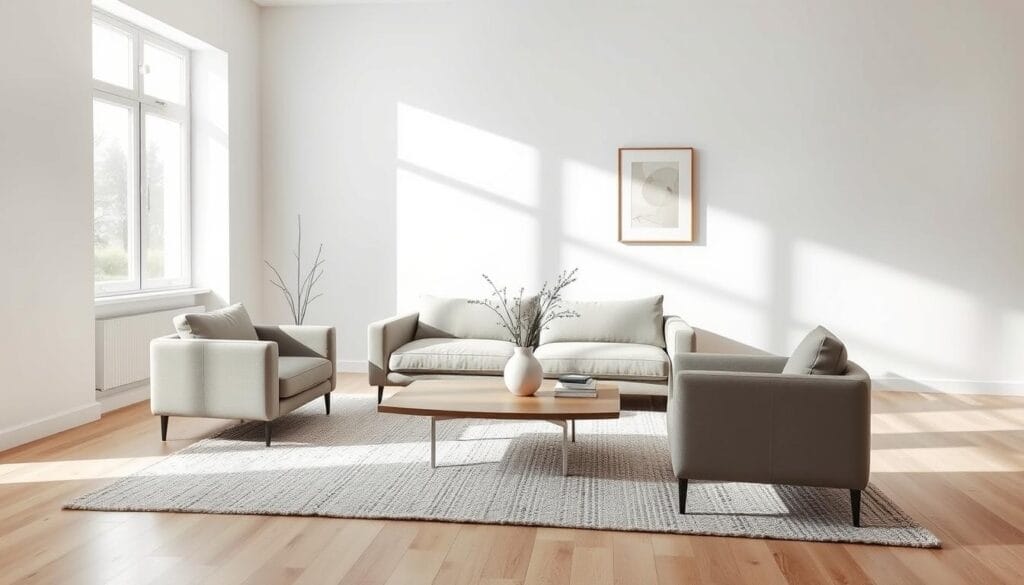
| Element | Consistency Tip |
|---|---|
| Wall Colors | Use the same color in multiple rooms |
| Cabinetry | Repeat style and material in connected spaces |
| Millwork | Consistent millwork collection throughout |
Personal Touches
Adding personal touches to a minimalist design is about balancing. You can add unique artworks or souvenirs that mean a lot to you. The trick is in how you place them. Keep the design clean by adding items without making a mess. A single picture or sculpture can show off your personality and keep the space looking neat.
Minimalist Decor
Choosing minimalist decor means picking pieces that fit the space well. Every item should have a purpose or make the room look better. For example, a remodeling in a Danish villa used crisp white and black-brown colors for a unified look. Using the same materials, like marble or wood, in different areas also connects the spaces nicely.
Combining these ideas is key for a cohesive minimalist home decor. Remember, following trends is okay, but staying true to your style is crucial for a timeless design. For more ideas, check out Design and Dwelling.
How to Maintain Your Minimalist Home
Keeping your minimalist home orderly doesn’t need to be a big task. It’s all about forming habits that help your space stay neat and good-looking. Here are some tips on making your minimalist house both useful and peaceful.
Regular Decluttering
Decluttering should happen often, not just once. Get rid of things you don’t need by checking your stuff regularly. Doing so makes cleaning faster, with a clean room taking less than 10 minutes to tidy up. Set times for decluttering now and then, like every month or every three months. This lets you keep only the things that truly matter to you.
Smart Storage Solutions
In a minimalist home, knowing how to store things is key. Use boxes, baskets, and furniture with more than one use to keep your place organized. For stuff you hardly use, big plastic boxes work great to keep them hidden but reachable. This helps keep your floors clear and your space looking big.
A home without clutter makes you feel more relaxed and gets more done. Applying these tips helps ensure your minimalist home stays true to its clean and simple design. This way, your living space mirrors the calm and order minimalist designs aim for.
| Activity | Traditional Time | Minimalist Time |
|---|---|---|
| Cleaning a cluttered room | 20-30 minutes | Less than 10 minutes |
| Cleaning cluttered kitchen counters | 5-10 minutes | About 1 minute |
| Weekly family cleaning | 1-2 hours | Approximately 30 minutes |
| Bi-weekly bathroom cleaning | 30-45 minutes | 10-15 minutes |
Conclusion
Turning your home into a minimalist space makes it beautiful and simple to live in. This guide gave you ideas and tips for a minimalist home that fits your style and needs. Minimalist buildings use fewer materials and energy, which helps the planet. They can also cost less to build because of simple designs and fewer materials.
Having less stuff means less stress, making you feel better mentally. New technologies, like modular furniture and smart systems, help keep a minimalist home updated. They blend simplicity with modern needs smoothly. Minimalist style also makes the most of natural light, making spaces calm and peaceful.
Starting a minimalist life means finding freedom and clearness in your surroundings. Enjoy making a space that shows who you are and fits your needs. Choosing high-quality materials and designs makes your home a calm and eco-friendly place. Cheers to a home that shows simplicity, beauty, and usefulness! 🌿

